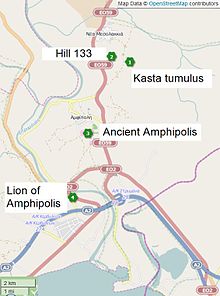Τύμβος Καστά[1] | |
 3D representation of the tomb structure | |
Location within Greece | |
| Alternative name | Amphipolis Tomb (Τάφος της Αμφίπολης) |
|---|---|
| Location | Amphipolis |
| Region | Central Macedonia, Greece |
| Coordinates | 40°50′23″N 23°51′48″E / 40.83972°N 23.86333°E |
| Type | Macedonian tomb |
| History | |
| Founded | Late 4th century BC[1] |
| Periods | Hellenistic |
| Associated with | Hephaestion |
| Site notes | |
| Excavation dates | 1964–present[2] |
| Archaeologists | Katerina Peristeri (Κατερίνα Περιστέρη) |
| Public access | Not accessible, excavations still under way |


The Kasta Tomb (Greek: Τύμβος Καστά), also known as the Amphipolis Tomb (Greek: Τάφος της Αμφίπολης), is the largest ancient tumulus (burial mound) ever discovered in Greece, and by comparison dwarfs that of Philip II of Macedon, father of Alexander the Great, in Vergina.[2][3]
It is an ancient Macedonian tomb of the last quarter of the 4th c. BC, and is enclosed in the Kasta mound near the ancient city of Amphipolis, Central Macedonia, in northern Greece. The first excavations at the mound in 1964 led to exposure of the perimeter wall, and further excavations in the 1970s uncovered many other ancient remains.[4] The inner tomb was first discovered in 2012 and entered in August 2014.[2]
The quality and artistic merit of the tomb contents indicate it contained important people. The remains of five people were found in the tomb.
- ^ a b "Συνέχιση ανασκαφικών εργασιών στον Τύμβο Καστά στην Αμφίπολη". www.yppo.gr. Ministry of Culture and Sport. 20 August 2014. Retrieved 10 September 2014.
- ^ a b c Andrew Marszal (7 September 2014). "Marble female figurines unearthed in vast Alexander the Great-era Greek tomb". www.telegraph.co.uk. The Daily Telegraph. Retrieved 10 September 2014.
- ^ Kate Müser (9 September 2014). "Greece's largest ancient tomb: Amphipolis". www.dw.de. Deutsche Welle. Retrieved 10 September 2014.
- ^ "Amphipolis", Ministry of Culture: ISBN 9602141263
